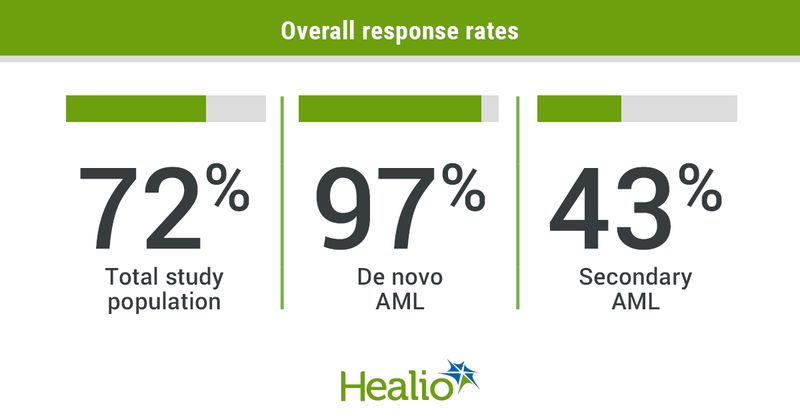Venetoclax plus intensive induction chemotherapy safe for fit, older patients with AML
Venetoclax in combination with 5 + 2 induction chemotherapy appeared safe for fit, older patients with acute myeloid leukemia, according to results of a phase 1b study published in Journal of Clinical Oncology.
Optimal post-remission therapy has not yet been determined, but the high remission rate in de novo AML warrants further investigation, researchers noted.

“To our knowledge, this is the rst study to show the safety and efcacy of combining the BCL-2 inhibitor venetoclax with intensive induction chemotherapy in t, older patients with AML,” Chong Chyn Chua, MBBS, BMedSci, FRACP, FRCPA, clinical hematologist at Warringal Private Hospital in Germany, and colleagues wrote. “Hematologic recovery times were not prolonged and early mortality was low.”
A previous study showed low-dose cytarabine in combination with venetoclax (Venclexta; AbbVie, Genentech) induced an overall response rate of 54% among older patients with AML deemed unfit for intensive chemotherapy, according to study background. Another study showed hypomethylating agents plus venetoclax induced an ORR of 68% without excess early mortality among patients unfit for intensive chemotherapy. However, it remained unknown whether venetoclax could be safely combined with intensive chemotherapy for fitter patients with AML.
In the open-label CAVEAT trial, Chua and colleagues assigned 51 patients aged 65 years or older with AML (aged 60 years or older if they had a monosomal karyotype) who were fit for intensive chemotherapy to one of five venetoclax dose-escalation groups, with doses ranging from 50 mg to 600 mg. The researchers administered the drug for 14 days per cycle.
Median age of participants was 72 years (range, 63-80).
After a 7-day prephase/dose ramp-up during induction, patients received an additional 7 days of venetoclax with 100 mg/m2 IV cytarabine on days 1 to 5 and 12 mg/m2 IV idarubicin on days 2 and 3. These who demonstrated response could receive four consolidation cycles consisting of 14 days of venetoclax in combination with cytarabine on days 1 and 2 and idarubicin on day 1.
Assessing the optimal dose schedule of venetoclax in combination with the 5 + 2 chemotherapy regimen served as the study’s primary endpoint.
Results showed the maximum tolerated dose of venetoclax was not reached, despite dose escalation to 600 mg per day.
Common grade 3 or higher nonhematologic toxicities during induction included febrile neutropenia (55%) and sepsis (35%).
Researchers observed a 72% ORR — which included complete remission or complete remission with incomplete count recovery — and a delayed platelet recovery during consolidation cycles. Patients with de novo AML had an ORR of 97%, compared with 43% for those with secondary AML.
Marrow blast reductions occurred in about half of patients with NPM1-, IDH2- and SESF2-mutant AML during the venetoclax prephase.
“Having demonstrated the feasibility of venetoclax in combination with 5 + 2 chemotherapy in older patients with AML, the main question is whether this regimen could succeed induction with 7 + 3 with or without gemtuzumab ozogamicin [Mylotarg, Pfizer] in de novo AML, CPX-351 [Vyxeos, Jazz Pharmaceuticals] in secondary AML, or venetoclax combined with low-dose cytarabine or a hypomethylating agent in older patients,” Chua and colleagues wrote. “Randomized studies will be necessary to denitively determine the role of venetoclax with intensive chemotherapy in these scenarios.”
As studies of venetoclax with the more standard 7 + 3 combination get underway, the current analysis “represents an important landmark in the eld,” Gert Ossenkoppele, MD, PhD, professor of hematology at Amsterdam University Medical Center, and Paresh Vyas, MD, PhD, professor of hematology at University of Oxford, wrote in an accompanying editorial.
“After a long time of having a relatively simple one-size-ts-all 7 + 3 approach followed by consolidation — with or without allogeneic stem cell transplantation — we are rightly now well into the age of more genetically directed therapy, where understanding genetic landscape at diagnosis may dictate quite differing treatment options,” Ossenkoppele and Vyas wrote. “Other therapeutic options for targeted agents can also be studied by international collaboration, including use in maintenance after achievement of [complete response], bridging to [allogeneic stem cell transplantation], and [minimal residual disease] conversion. Further down the line, as we increasingly monitor genetic clonal evolution, constructing trials to deal with this issue will become the next challenge.”
References
- Chua CC, et al. J Clin Oncol. 2020;doi:10.1200/ JCO.20.00572.
- Ossenkoppele G and Vyas P. J Clin Oncol. 2020;doi:10.1200/JCO.20.01788.
